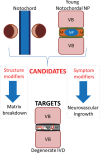Notochordal cell-derived therapeutic strategies for discogenic back pain
- PMID: 24436871
- PMCID: PMC3854597
- DOI: 10.1055/s-0033-1350053
Notochordal cell-derived therapeutic strategies for discogenic back pain
Abstract
An understanding of the processes that occur during development of the intervertebral disk can help inform therapeutic strategies for discogenic pain. This article reviews the literature to identify candidates that are found in or derived from the notochord or notochordal cells and evaluates the theory that such factors could be isolated and used as biologics to target the structural disruption, inflammation, and neurovascular ingrowth often associated with discogenic back pain. A systematic review using PubMed was performed with a primary search using keywords "(notochordal OR notochord) And (nerves OR blood vessels OR SHH OR chondroitin sulfate OR notch OR CTGF) NOT chordoma." Secondary searches involved keywords associated with the intervertebral disk and pain. Several potential therapeutic candidates from the notochord and their possible targets were identified. Studies are needed to further identify candidates, explore mechanisms for effect, and to validate the theory that these candidates can promote structural restoration and limit or inhibit neurovascular ingrowth using in vivo studies.
Keywords: CTGF; Notch; Semaphorin 3A; chondroitin sulfate; intervertebral; notochord; notochordal cells; sonic hedgehog.
Conflict of interest statement
Figures




References
-
- Stemple D L. Structure and function of the notochord: an essential organ for chordate development. Development. 2005;132:2503–2512. - PubMed
-
- Anderson C N, Ohta K, Quick M M, Fleming A, Keynes R, Tannahill D. Molecular analysis of axon repulsion by the notochord. Development. 2003;130:1123–1133. - PubMed
-
- Reese D E, Hall C E, Mikawa T. Negative regulation of midline vascular development by the notochord. Dev Cell. 2004;6:699–708. - PubMed
Publication types
Grants and funding
LinkOut - more resources
Full Text Sources
Other Literature Sources
Miscellaneous

